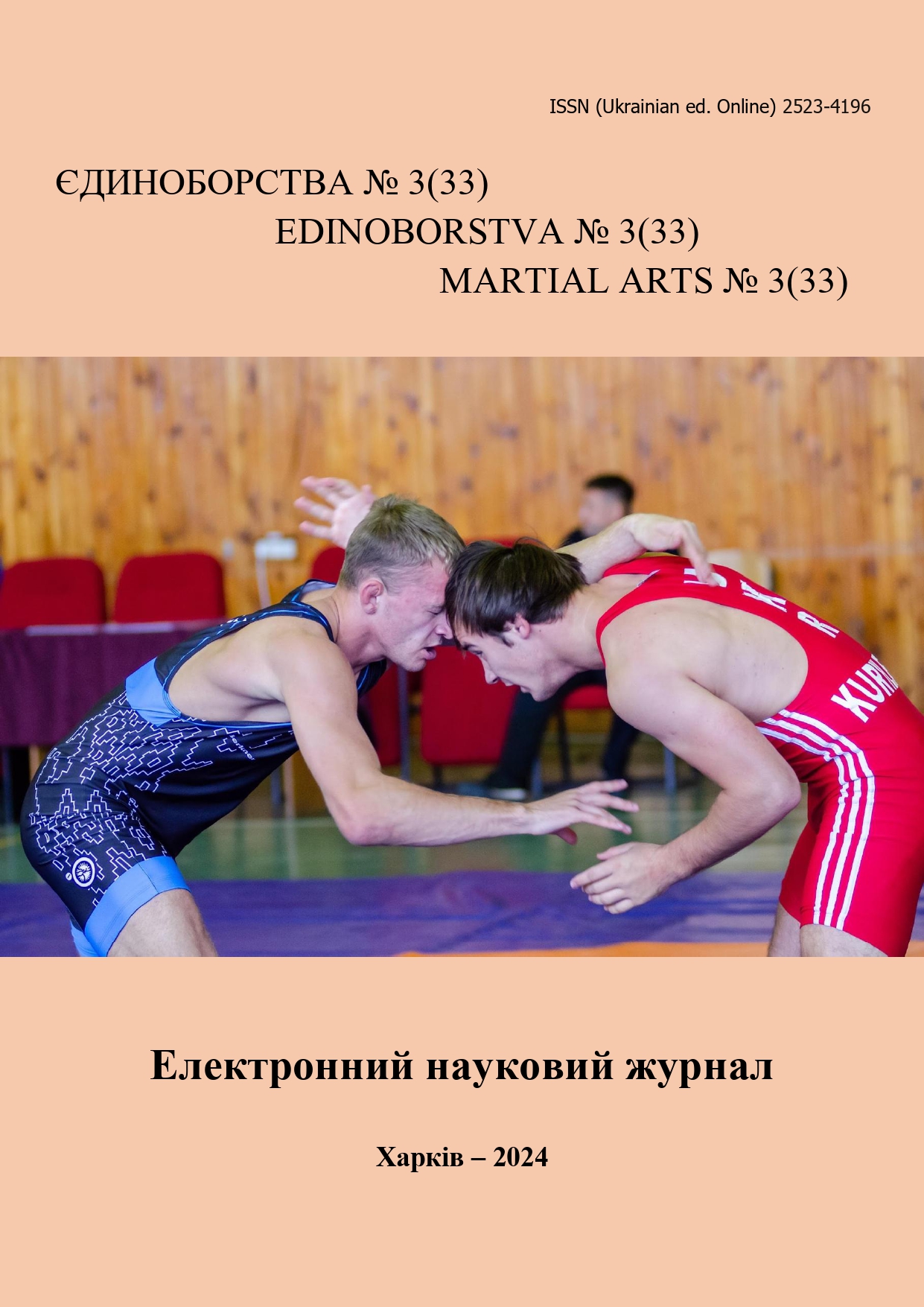The influence of boxing on the psycho-emotional state of adolescents under martial law
DOI:
https://doi.org/10.15391/ed.2024-3.04Keywords:
martial law, adolescents, psycho-emotional state, boxing, questionnaireAbstract
Purpose: to determine the impact of boxing on the psycho-emotional state of adolescents under martial law. Material and Methods. analysis and generalization of scientific and methodological literature; questionnaire to identify the motivation of adolescents to boxing and their psycho-emotional state, social and psychological adaptability during the war; methods of mathematical statistics. The study involved 16 young men with no training experience, the average age was 15,8±0,7 years. The participants of the study were engaged in boxing for a year in sports clubs. Classes were held 5 times a week for 120 minutes. Results: it was found that the main motivations for boxing are socio-moral and socio-emotional satisfaction from practicing this sport. The conducted surveys and questionnaires on the psycho-emotional state and socio-psychological adaptability of adolescents during martial law made it possible to state the fact that young men already have psychological changes. It was found that under the influence of boxing training, the level of anxiety in adolescents decreased, and it was also found that psychoemotional indicators improved. Thus, at the end of the training year only 1 adolescent from the section remained with a very high level of anxiety, which amounted to 6,25 %, the number of adolescents with clearly increased anxiety decreased to 3 people (18,75 %). The number of adolescents who began to have a normal level of anxiety at the end of the study increased significantly. It has been established that under the influence of boxing training there were more positive changes in the formation of mental qualities such as «self-perception» (t=2,31; p<0,05), «internal» (t=2,31; p<0,05) and «external locus of control» (t=2,18; p<0,05), «emotional comfort» (t=2,40; p<0,05) and «discomfort» (t=2,33; p<0,05) and «escape from problem solving» (t=2,42; p<0,05). These results indicate that boxing training sessions had a positive impact on the level of psycho-emotional state of adolescents. Conclusions. It has been established that boxing training has a positive effect on the psycho-emotional state of adolescents, which in turn gives grounds to assert that physical activity is really important for the mental health of adolescents who are most sensitive to the effects of martial law.
References
Бойко, Г.Л., Козлова, Т.Г., & Шарафутдінова, С.У. (2022). Досягнення ефекту дотримання норм рухової активності та формування стресостійкості у здобувачів вищої освіти в умовах російсько-української війни. Фізичне виховання в контексті сучасної освіти, 17‒19.
Грузинська, І.М. (2022). Проблема емоційного реагування на стресові ситуації в умовах воєнного стану. Вісник Національного авіаційного університету. Серія: Педагогіка. Психологія, 2(21), 97-107.
Кузікова, С.Б., Зливков, В.Л., & Лукомська, С.О. (2022). Вікові особливості переживання травм війни: інтегративний підхід. Науковий вісник Херсонського державного університету, 64-70. DOI: 10.32999/ksu2312-3206/2022-2-9
Кулаков, Б., Поляничко, О., & Єретик, А. (2022). Взаємозв'язок показників загальної та спеціальної фізичної підготовленості боксерів 14-15 років. Єдиноборства, (2 (24)), 36-47. DOI:10.15391/ed.2022-2.04
Мартинюк, Ю.Є., Джим, В.Ю., & Гребньова, І.В. (2023). Порівняльний аналіз силових поодиноких ударів руками у кваліфікованих боксерів різних типів манер ведення двобою. Науковий часопис Національного педагогічного університету імені М. П. Драгоманова, (5(164), 95-100. DOI:10.31392/NPU-nc.series15.2023.5(164).21
Марченко, О., Бричук, М., & Дєдух, М. (2022). Особливості мотивації студентів до самостійних занять руховою активністю в умовах воєнного стану. Теорія і методика фізичного виховання і спорту, 3, 44‒50.
Марчик, В.І. (2023). Вплив рухової активності на прояв стресу у студентів під час війни. Навчання, виховання й розвиток гармонійно розвиненої особистості в процесі занять фізичною культурою і спортом : монографія / за ред. проф. В. М. Пристинського, Т. М. Пристинської. Слов’янськ: ДВНЗ «Донбаський державний педагогічний університет».
Мулик, В.В., Шестак, Ю.С., & Окунь, Д.О. (2019). Використання спеціальних боксерських споряджень у загальній фізичній підготовці юних боксерів 15-16 років. Науковий часопис НПУ імені М.П. Драгоманова, 11 (119), 184-189.
Наугольник, Л.Б. (2015). Психологія стресу: підручник. Львівський державний університет внутрішніх справ, Львів.
Собкова, С.І., & Гаркавенко, Н.В. (2019). Компоненти психічного і психологічного здоров’я підлітка як чинники його особистісного здоров’я. Теорія і практика сучасної психології, №6, Т.2, 27-31.
Щербакова, О.О., Кондрацька, Л.В., & Беженська, А.А. (2023). Вікові особливості психоемоційного стану підлітків в умовах війни. ГАБІТУС, 55, 67-71.
De Jong, J. et al (2002). Trauma, War and Violence: Public mental health in socio-economic context. New York; Boston; Dordrecht; London: Kluwer Academic Press.
Dupuy, K. & Peters, K. (2010). War and children: a reference handbook. Santa Barbara; Denver; Oxford: Praeger Security International, ABC Clio.
Ferrari F. (2013). Handbook of Resilience in Children of War. New York; Heidelberg; Dordrecht; London: Springer.
Jones, L. (2013). Then they started shooting: Children of the Bosnian war and the adults they become. New York: Bellevue Literary Press.
Murthy, S. & Lakshminarayana R. (2006). Mental health consequences of war: a brief review of research findings. World Psychiatry, № 5 (1), 25–30.
Smith, D. (2001). Children in the heat of war. APA Monitor, № 32(8), 29.













